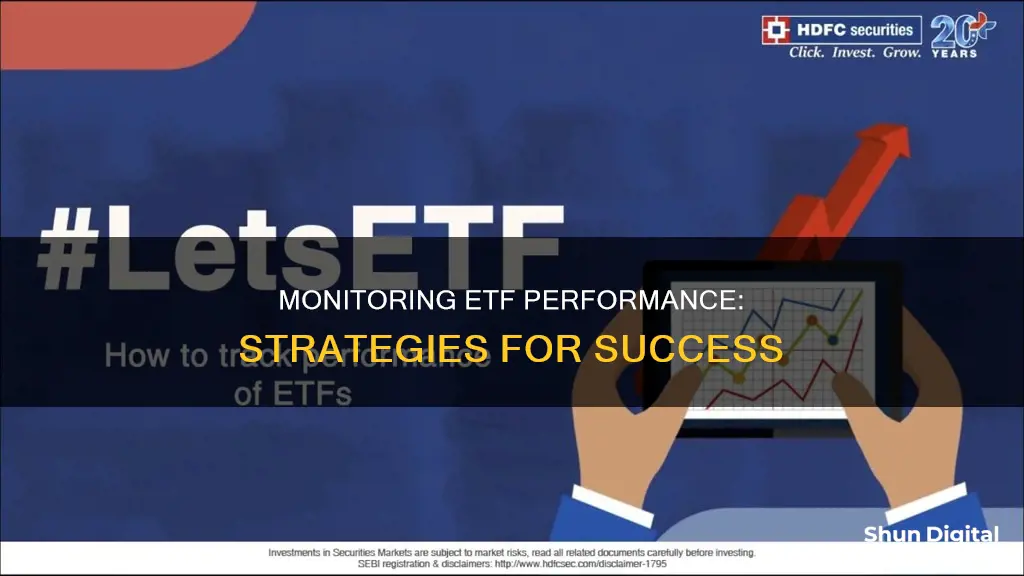
Exchange-Traded Funds (ETFs) have become increasingly popular in recent years, with investors attracted by their liquidity, portfolio diversification, and low entry costs. However, with so many options available, it can be challenging to know which funds to pick and how to monitor their performance. Here are some key considerations for evaluating and tracking the performance of ETFs in your portfolio:
| Characteristics | Values |
|---|---|
| Compare to other ETFs | Use resources like Globefund or Morningstar to see how an ETF is performing relative to other similar funds |
| Compare to its benchmark | Most passive ETFs track a specific benchmark. However, the ETF might deviate from the index occasionally, especially when demand for an ETF drives its share prices up or down. This is called tracking error and it can put an ETF temporarily out of sync with the index it tracks. |
| Disclosure documents | Documents such as the ETF summary document, prospectus, periodic portfolio disclosure, and management reports of fund performance can help assess an ETF. |
| Review account statements | Review account statements to see how your investments are doing and keep track of the costs you’re paying. Then compare the performance of your investment portfolio against your goals and the guidelines set out in your investment policy statement, if you have one. |
| Consult your advisor | Ask your advisor to explain why the price of your ETFs have suddenly fallen or risen and what that means for your portfolio. |
| Follow stock market news | The value of the ETF will be affected by any factors that affect the price of the stocks, bonds or other assets making up that ETF. |
| General economic news | Find out what’s happening in the economy, including interest rates, inflation rate, and how the local currency is doing against others. |
| Expense ratio | The expense ratio is the amount of a fund's assets used for operating expenses. A lower expense ratio is better. |
| Index methodology | Most of the indexes to which U.S.-listed equity ETFs are linked use a market capitalization-weighting strategy. However, ETFs utilizing "alternative" weighting methodologies have become increasingly popular. |
| Depth of holdings | The depth of exposure offered by similar ETFs can vary significantly, and this can have a notable impact on an ETF’s risk/return profile. |
| Tracking error | Tracking error is a good measure of the efficiency of the ETF manager. The smaller the difference between an ETF and its underlying index, the better. |
| Capital gains distributions | A good way to measure tax efficiency is by examining the distribution history for the fund. Ideally, ETFs will make zero short-term capital gains distributions. |
What You'll Learn

Compare ETF performance to other ETFs
Comparing your ETF's performance to that of other ETFs is a crucial aspect of monitoring your investment. Here are some instructive guidelines on how to effectively compare ETF performance:
Utilise Online Tools:
Use online platforms such as Globefund, Morningstar, ETF Database, or justETF to compare how your ETF is performing relative to other similar funds. These tools allow you to select multiple ETFs and compare their characteristics, including performance, risk measures, and technical indicators. They provide a comprehensive overview of different ETFs, enabling you to make informed decisions.
Compare Performance and Risk:
When comparing ETFs, focus on both performance and risk. Evaluate the returns generated by different ETFs over specific periods, such as the last six months or calendar years. Additionally, consider the average volatility of the ETFs, which represents the positive and negative deviations from the average return. This information helps you assess the potential gains and losses associated with each investment.
Customise Comparison Criteria:
Customise the comparison criteria based on your specific needs and investment strategy. For instance, you can compare ETFs from different asset classes, such as bond and equity ETFs, to ensure you're diversifying your portfolio effectively.
Benchmarking:
Consider benchmarking your portfolio against an ETF. Exchanged-traded funds make excellent portfolio benchmarks because they consider all aspects of a real portfolio, including fees, dividends, and franking credits. Benchmarking tools allow you to select an ETF as a reference point and compare its performance with your portfolio's performance.
Tracking ETF Performance:
ETFs have an open-ended structure, which means that fund managers can issue additional units when investors want to purchase more. Consequently, ETFs trade at a unit price close to the value of the underlying assets, making their performance tracking similar to that of stocks. Keep an eye on the price movements of your ETF on stock exchanges, just like you would for individual stocks.
By following these guidelines, you can effectively compare the performance of your ETF to that of other ETFs, helping you make informed investment decisions and optimise your portfolio's performance.
Spotting Backlight Bleed on Your Monitor
You may want to see also

Compare to its benchmark
Comparing an ETF's performance to its benchmark is a crucial aspect of investing, as it helps you measure the results and determine how your portfolio is performing over time. Here's a detailed guide on how to compare an Exchange-Traded Fund's (ETF) performance to its benchmark:
Understanding Benchmarks:
Firstly, it's important to understand what a benchmark is and why it matters. A benchmark is a standard or a yardstick against which you can measure the performance of your ETF. It helps you evaluate how your investment portfolio is doing in comparison to an alternative or a standard.
Selecting the Appropriate Benchmark:
The appropriate benchmark for an ETF depends on the index or sector it tracks. For example, the S&P 500 is a commonly used benchmark index for broad-based portfolios and ETFs like the SPY. If you're holding small-cap stocks, the Russell 2000 Index could be a suitable benchmark.
Passive vs. Active ETFs:
It's also essential to understand the difference between passive and actively managed ETFs. Passive ETFs aim to replicate or mimic the performance of the benchmark index. On the other hand, actively managed ETFs have fund managers who actively make investment decisions with the goal of surpassing the benchmark returns.
Evaluating Performance:
When comparing an ETF's performance to its benchmark, consider the following:
- Relative Performance: This shows how your portfolio is performing relative to the benchmark. If your portfolio is underperforming compared to the benchmark, it may prompt you to reevaluate your investments or consult your financial advisor.
- Risk Assessment: Along with performance, consider the risk associated with the ETF. You can compare the portfolio's beta to the benchmark, where a beta of 1.0 indicates the portfolio moves in tandem with the index. A beta less than 1.0 suggests lower volatility, while a beta greater than 1.0 indicates higher volatility.
- Fees and Expenses: Keep in mind that fees and commissions will reduce the returns on your ETF investments. These expenses include management fees and operating expenses, which are reflected in the published rate of return.
- Long-Term Performance: Consider evaluating the performance of the ETF over an extended period, as short-term underperformance may not reveal much. Look at trailing quarters, years, and even ten-year periods to identify potential trends.
- Diversification: Benchmarks can help guide your asset allocation and diversification strategies. They provide a framework for investors to diversify across different asset classes and sectors, allowing for strategic asset allocation.
- Risk Implications: While benchmarking is valuable, keep in mind that it may not always capture all the risk implications. Factors like liquidity risk, tracking error, and market impact might be overlooked in a benchmark's risk assessment.
Tools for Comparison:
To make the comparison process easier, you can utilise tools such as Globefund or Morningstar, which allow you to compare how a particular ETF is performing relative to other similar funds and their respective benchmarks. Additionally, Sharesight is a platform that offers benchmarking tools, enabling you to compare your portfolio's performance against various ETFs.
In summary, comparing an ETF's performance to its benchmark is essential for evaluating the success of your investment strategy. It helps you assess if your portfolio is meeting your financial goals and risk tolerance, allowing you to make informed decisions about your investments.
LCD Monitor Technology: Advancements and Innovations
You may want to see also

Review disclosure documents
Disclosure documents are important for investors to assess an ETF and understand the risks, past performance, and costs of investing in it. These documents are required by securities regulators and can be found on the System for Electronic Document Analysis and Retrieval (SEDAR). Here are some key points to keep in mind when reviewing disclosure documents for an ETF:
- Summary Document: The "ETF Facts" or "Fund Fact" document provides a concise overview of the ETF, including information on how the fund trades, its investments, and its risk level. This document is written in plain language and is typically no longer than two pages, making it a good starting point for investors.
- Prospectus: The prospectus is a legal document that sets out the key facts and details of the ETF. It provides more comprehensive information than the summary document and is worth reviewing to understand the ETF's structure, objectives, and potential risks.
- Periodic Portfolio Disclosure: Investors can gain insights into the ETF's portfolio holdings through periodic disclosures. These typically include the top 25 portfolio holdings on a quarterly basis and a full portfolio listing on a semi-annual or annual basis. This information helps investors understand the underlying assets and assess diversification.
- Management Reports: Review management reports of fund performance to analyse how the ETF has performed over time. These reports often include financial statements, management discussions, and analyses of the ETF's holdings and strategy.
- Website Disclosures: According to Rule 6c-11 in the US, ETFs are required to disclose certain information on their websites. This includes portfolio holdings, net asset value per share, market price, premium or discount information, and bid-ask spread data. These disclosures provide transparency and help investors make informed decisions.
- Risk Classification: Pay attention to the risk classification methodology disclosed in the documents. This information helps investors understand the investment risk levels associated with the ETF and make informed decisions about their risk tolerance and investment goals.
Connecting iPhone to Monitor: A Comprehensive Guide
You may want to see also

Review account statements
Reviewing your account statements is a crucial step in monitoring the performance of your Exchange-Traded Funds (ETFs). Here are some detailed instructions on how to review your account statements effectively:
Understanding Account Statements:
Familiarise yourself with the format and content of your account statements. These statements provide valuable information about your investments and their performance. Look for sections that outline your investment portfolio's performance, costs, and fees associated with your ETFs.
Tracking Investment Performance:
Review your account statements regularly to track how your ETFs are performing. Compare the performance of your investments against your financial goals and guidelines outlined in your investment policy statement. Don't get too caught up in short-term performance; just because an ETF did well last year doesn't guarantee it will repeat that performance. Ensure that your ETFs align with your investment strategy and risk tolerance.
Analysing Costs and Fees:
Keep a close eye on the costs and fees associated with your ETFs. These expenses can impact your overall returns. Look for management fees, operating expenses (MER), and any other charges specified in the account statements. Compare these costs with those of similar ETFs to ensure you're getting a competitive deal.
Monitoring Risk and Returns:
Review your account statements to assess the risk and return profile of your ETFs. Evaluate how well your ETFs replicate the performance of their underlying indexes. Look for tracking errors or deviations from their benchmarks. Additionally, consider the depth of holdings—the number of underlying securities an ETF holds—as this can impact its risk and return potential.
Evaluating Tax Implications:
ETFs have tax implications that can affect your overall returns. Review your account statements to understand the tax treatment of your ETFs. Look for capital gains distributions and ordinary income distributions. Compare the tax efficiency of your ETFs with other investment options to make informed decisions.
By regularly reviewing your account statements and considering the points above, you can gain valuable insights into the performance, costs, risks, and tax implications of your ETFs. This information will help you make more informed investment decisions and ensure your portfolio aligns with your financial goals.
Salvaging a Broken ASUS Monitor: Options and Recommendations
You may want to see also

Consult an advisor
Consulting a financial advisor is a good idea when monitoring the performance of your ETF investments. They can explain the reasons behind sudden price changes and what this means for your portfolio.
Financial advisors are qualified professionals who can provide expert guidance on investment strategies and help you make informed decisions about your financial goals. They can offer a comprehensive analysis of your portfolio, taking into account your risk tolerance, investment horizon, and financial circumstances.
When choosing an advisor, ensure they are certified and have extensive knowledge of the stock market and ETFs. They should be able to provide insights into the broader economic trends and factors influencing the performance of your ETFs.
Additionally, a good advisor will tailor their advice to your specific needs and goals. They should be able to explain complex financial concepts in a clear and concise manner, ensuring you understand the rationale behind their recommendations.
It is also beneficial to consult an advisor who has experience in the type of investments you are interested in. For example, if you are considering investing in ETFs that track a specific index or sector, your advisor should have expertise in that area. They can then provide you with valuable insights and help you make informed decisions about your investments.
Removing Pip Monitors: A Step-by-Step Guide
You may want to see also
Frequently asked questions
Monitoring the performance of an ETF is similar to tracking the performance of any other stock, as ETFs are listed (and traded) on stock exchanges. You can use resources like Globefund or Morningstar to see how an ETF is performing relative to other similar funds, and compare it to its benchmark.
It's important to follow a fund's expense ratio, tracking results, and capital gains history when evaluating an ETF. A good measure of an ETF's efficiency is the "tracking difference", which looks at how far an ETF has lagged its benchmark over a one-year period.
Monitoring the performance of an ETF can help investors make informed decisions about their portfolio's composition and assess whether the ETF is meeting their investment goals.







